
Kaiser Lab
@clocksevolution.bsky.social
We explore how evolution, ecology and biological clocks interact,
with a focus on lunar rhythms in development and reproduction
of the marine insect Clunio.
+ Genomics | Biodiversity | Behaviour | NeuroBio | MolBio | SciCom
bit.ly/KaiserLab
with a focus on lunar rhythms in development and reproduction
of the marine insect Clunio.
+ Genomics | Biodiversity | Behaviour | NeuroBio | MolBio | SciCom
bit.ly/KaiserLab
WE ARE HIRING!
Please spread widely!
#Postdoc in #Evolutionary #Genomics
-> www.mpg.de/25524526/
#Postdoc in #Molecular #Biology & #Cell #Signalling
-> www.mpg.de/25524509/
@mpi-evolbio.bsky.social @maxplanck.de
#ScienceJobs #EvoBio #MolBio #Ecology #Chronobiology #Marine #EntoSky #Biodiversity
Please spread widely!
#Postdoc in #Evolutionary #Genomics
-> www.mpg.de/25524526/
#Postdoc in #Molecular #Biology & #Cell #Signalling
-> www.mpg.de/25524509/
@mpi-evolbio.bsky.social @maxplanck.de
#ScienceJobs #EvoBio #MolBio #Ecology #Chronobiology #Marine #EntoSky #Biodiversity

October 9, 2025 at 6:56 AM
WE ARE HIRING!
Please spread widely!
#Postdoc in #Evolutionary #Genomics
-> www.mpg.de/25524526/
#Postdoc in #Molecular #Biology & #Cell #Signalling
-> www.mpg.de/25524509/
@mpi-evolbio.bsky.social @maxplanck.de
#ScienceJobs #EvoBio #MolBio #Ecology #Chronobiology #Marine #EntoSky #Biodiversity
Please spread widely!
#Postdoc in #Evolutionary #Genomics
-> www.mpg.de/25524526/
#Postdoc in #Molecular #Biology & #Cell #Signalling
-> www.mpg.de/25524509/
@mpi-evolbio.bsky.social @maxplanck.de
#ScienceJobs #EvoBio #MolBio #Ecology #Chronobiology #Marine #EntoSky #Biodiversity
Our current follow-up #modelling study with @gokhalecs.bsky.social, former colleague @mpi-evolbio.bsky.social, suggests that larval competition for space can actually drive the evolution of divergent reproductive timing, aka #allochrony, which results in spatial separation and reduced competition.

September 17, 2025 at 8:12 AM
Our current follow-up #modelling study with @gokhalecs.bsky.social, former colleague @mpi-evolbio.bsky.social, suggests that larval competition for space can actually drive the evolution of divergent reproductive timing, aka #allochrony, which results in spatial separation and reduced competition.
Previous work with @kokkonut.bsky.social (tinyurl.com/28hxwree) showed that #sympatric Clunio strains reproduce AT full #moon or BEFORE new moon. During these times low tide levels differ, placing the eggs & larvae at different elevations. This spatial separation allows #coexistence of the strains:

September 17, 2025 at 8:12 AM
Previous work with @kokkonut.bsky.social (tinyurl.com/28hxwree) showed that #sympatric Clunio strains reproduce AT full #moon or BEFORE new moon. During these times low tide levels differ, placing the eggs & larvae at different elevations. This spatial separation allows #coexistence of the strains:
Curious how the #moon is perceived, controls #development, and may drive #speciation in a #marine #insect?
Check our posters at #EBRS2025:
> P107 (Tue) @juleneumann.bsky.social
> P135 (Tue)
> P196 (Thu) @kokkonut.bsky.social @gokhalecs.bsky.social
#chronobiology #circalunar #evolution #ecology
Check our posters at #EBRS2025:
> P107 (Tue) @juleneumann.bsky.social
> P135 (Tue)
> P196 (Thu) @kokkonut.bsky.social @gokhalecs.bsky.social
#chronobiology #circalunar #evolution #ecology

August 22, 2025 at 7:44 AM
Curious how the #moon is perceived, controls #development, and may drive #speciation in a #marine #insect?
Check our posters at #EBRS2025:
> P107 (Tue) @juleneumann.bsky.social
> P135 (Tue)
> P196 (Thu) @kokkonut.bsky.social @gokhalecs.bsky.social
#chronobiology #circalunar #evolution #ecology
Check our posters at #EBRS2025:
> P107 (Tue) @juleneumann.bsky.social
> P135 (Tue)
> P196 (Thu) @kokkonut.bsky.social @gokhalecs.bsky.social
#chronobiology #circalunar #evolution #ecology
One week to go until #EBRS2025 in #Lübeck!
We are very much looking forward to exciting #chronobiology!
#circatidal #circadian #circalunar #circannual
Sessions on:
-> #Evolution
-> Short and long #clocks
-> Clocks in the #wild
-> #Seasonality
... and many more:
ebrs-online.org/index.php/ev...
We are very much looking forward to exciting #chronobiology!
#circatidal #circadian #circalunar #circannual
Sessions on:
-> #Evolution
-> Short and long #clocks
-> Clocks in the #wild
-> #Seasonality
... and many more:
ebrs-online.org/index.php/ev...

August 18, 2025 at 6:19 AM
One week to go until #EBRS2025 in #Lübeck!
We are very much looking forward to exciting #chronobiology!
#circatidal #circadian #circalunar #circannual
Sessions on:
-> #Evolution
-> Short and long #clocks
-> Clocks in the #wild
-> #Seasonality
... and many more:
ebrs-online.org/index.php/ev...
We are very much looking forward to exciting #chronobiology!
#circatidal #circadian #circalunar #circannual
Sessions on:
-> #Evolution
-> Short and long #clocks
-> Clocks in the #wild
-> #Seasonality
... and many more:
ebrs-online.org/index.php/ev...
Happy to share that we just published two papers from an exciting and fruitful collaboration with Hanna Kokko, involving Runa Ekrem, Alec Jacobsen and Lotte de Vries!
@kokkonut.bsky.social @lottedevries.bsky.social
#Evobio #MarineEcology #Ecology #Modelling #Chronobiology
Picture by Solvin Zankl
@kokkonut.bsky.social @lottedevries.bsky.social
#Evobio #MarineEcology #Ecology #Modelling #Chronobiology
Picture by Solvin Zankl
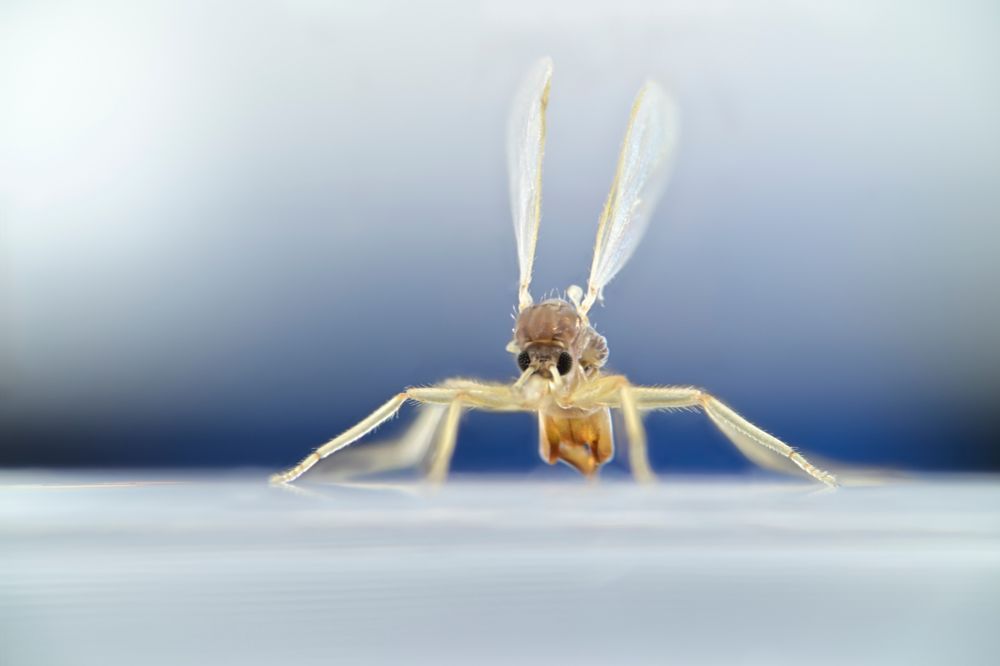
July 21, 2025 at 9:00 AM
Happy to share that we just published two papers from an exciting and fruitful collaboration with Hanna Kokko, involving Runa Ekrem, Alec Jacobsen and Lotte de Vries!
@kokkonut.bsky.social @lottedevries.bsky.social
#Evobio #MarineEcology #Ecology #Modelling #Chronobiology
Picture by Solvin Zankl
@kokkonut.bsky.social @lottedevries.bsky.social
#Evobio #MarineEcology #Ecology #Modelling #Chronobiology
Picture by Solvin Zankl
If you want to know more about #circalunar #clocks, the following might also be interesting:
onlinelibrary.wiley.com/doi/full/10....
#lunar #moon #tides #chronobiology
onlinelibrary.wiley.com/doi/full/10....
#lunar #moon #tides #chronobiology

July 5, 2025 at 8:08 AM
If you want to know more about #circalunar #clocks, the following might also be interesting:
onlinelibrary.wiley.com/doi/full/10....
#lunar #moon #tides #chronobiology
onlinelibrary.wiley.com/doi/full/10....
#lunar #moon #tides #chronobiology
(5/5) #Research
Our group studies these timing adaptations with #genomic and #molecular tools, aiming to decode the unknown lunar clockwork. We also explore the role of #biological #clocks in #ecology, #evolution and #conservation.
@juleneumann.bsky.social @cperalta.bsky.social
Our group studies these timing adaptations with #genomic and #molecular tools, aiming to decode the unknown lunar clockwork. We also explore the role of #biological #clocks in #ecology, #evolution and #conservation.
@juleneumann.bsky.social @cperalta.bsky.social
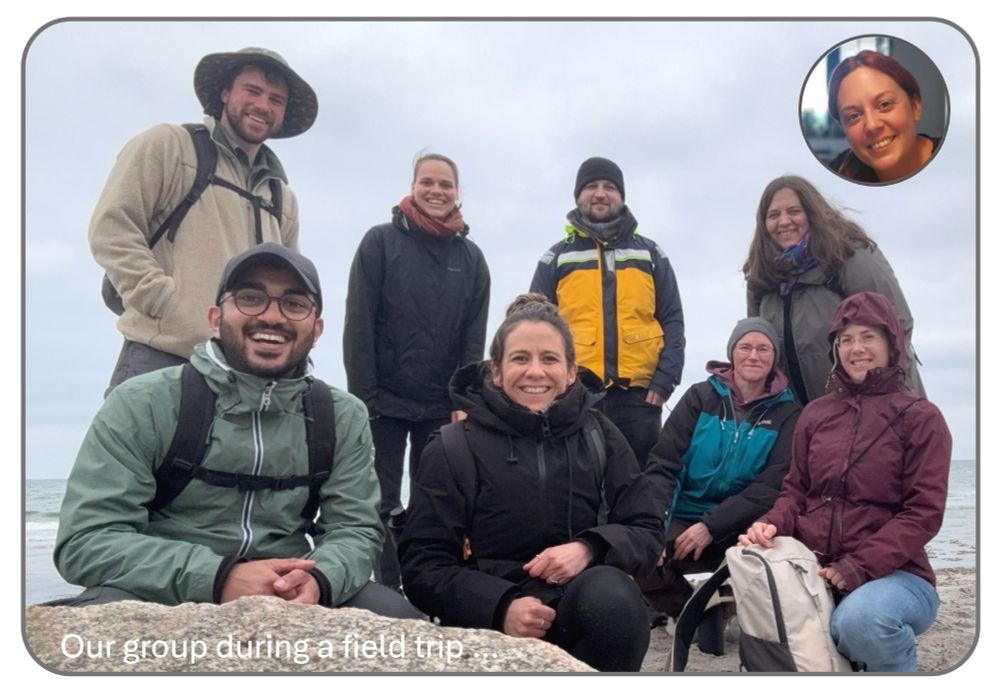
June 23, 2025 at 8:46 AM
(5/5) #Research
Our group studies these timing adaptations with #genomic and #molecular tools, aiming to decode the unknown lunar clockwork. We also explore the role of #biological #clocks in #ecology, #evolution and #conservation.
@juleneumann.bsky.social @cperalta.bsky.social
Our group studies these timing adaptations with #genomic and #molecular tools, aiming to decode the unknown lunar clockwork. We also explore the role of #biological #clocks in #ecology, #evolution and #conservation.
@juleneumann.bsky.social @cperalta.bsky.social
(4/5) #LocalAdaptation
But the tides differ along the coastline. Therefore, the lunar clock of Clunio populations from different places needs specific adaptations to the local tides.
But the tides differ along the coastline. Therefore, the lunar clock of Clunio populations from different places needs specific adaptations to the local tides.
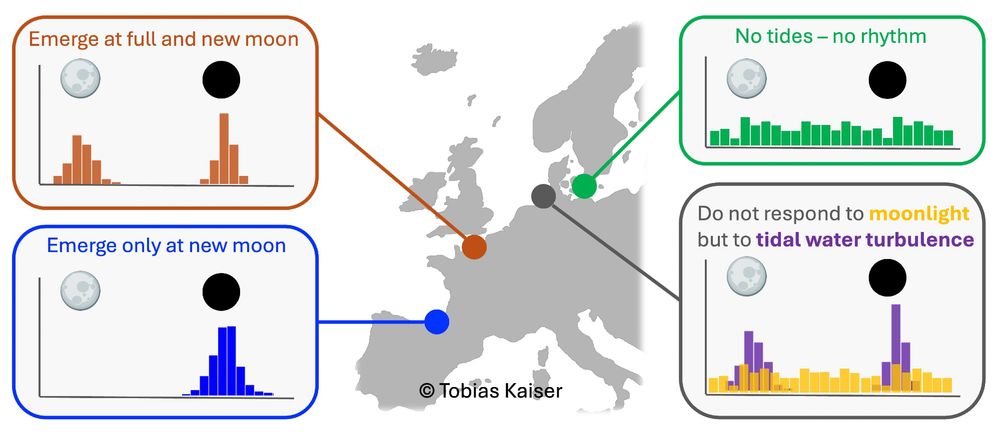
June 23, 2025 at 8:46 AM
(4/5) #LocalAdaptation
But the tides differ along the coastline. Therefore, the lunar clock of Clunio populations from different places needs specific adaptations to the local tides.
But the tides differ along the coastline. Therefore, the lunar clock of Clunio populations from different places needs specific adaptations to the local tides.
(3/5) #Lunar #Rhythm
… and then time these hours to the lowest low tides. These tides always occur at full and new #moon. Clunio has an internal timer, a so-called #circalunar #clock. It enables the midges to predict #moon phases and allows adults to only emerge at the right #time.
… and then time these hours to the lowest low tides. These tides always occur at full and new #moon. Clunio has an internal timer, a so-called #circalunar #clock. It enables the midges to predict #moon phases and allows adults to only emerge at the right #time.

June 23, 2025 at 8:46 AM
(2/5) #LifeCycle
Clunio’s long-lived larvae prefer to be submerged and therefore settle in the lower parts of the intertidal zone. However, the adults need these regions to be exposed for egg-laying. The solution was to reduce adult lifespan – and thereby mating and egg-laying – to a few hours …
Clunio’s long-lived larvae prefer to be submerged and therefore settle in the lower parts of the intertidal zone. However, the adults need these regions to be exposed for egg-laying. The solution was to reduce adult lifespan – and thereby mating and egg-laying – to a few hours …
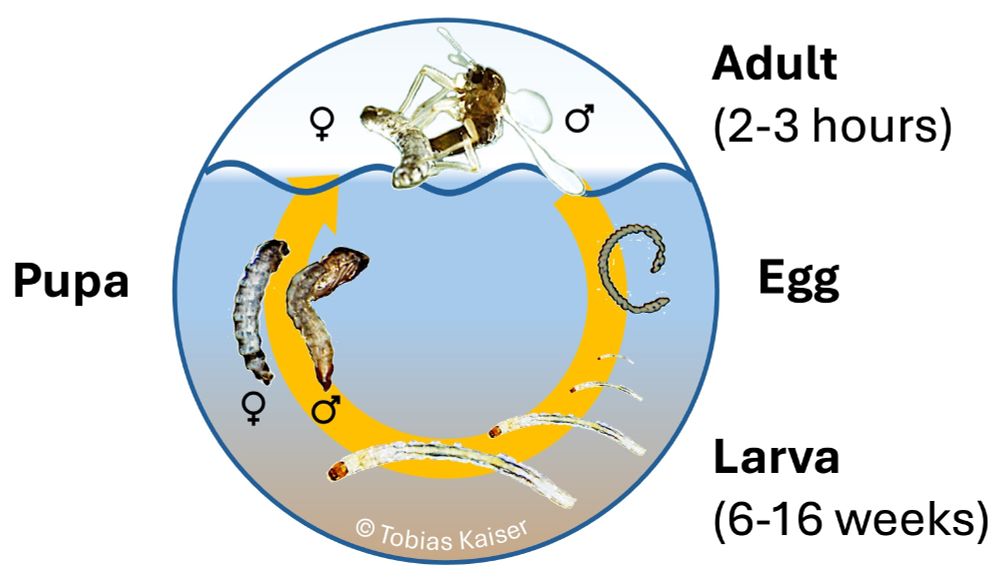
June 23, 2025 at 8:46 AM
(2/5) #LifeCycle
Clunio’s long-lived larvae prefer to be submerged and therefore settle in the lower parts of the intertidal zone. However, the adults need these regions to be exposed for egg-laying. The solution was to reduce adult lifespan – and thereby mating and egg-laying – to a few hours …
Clunio’s long-lived larvae prefer to be submerged and therefore settle in the lower parts of the intertidal zone. However, the adults need these regions to be exposed for egg-laying. The solution was to reduce adult lifespan – and thereby mating and egg-laying – to a few hours …
#Moonstruck #Midges: Introducing Clunio marinus
#Clunio is a midge and a truly #marine #insect. You can find it on the #European #Atlantic #coast in the #intertidal zone. This is the region between the low #tide and high tide, alternating between marine and terrestrial conditions.
(1/5)
#Clunio is a midge and a truly #marine #insect. You can find it on the #European #Atlantic #coast in the #intertidal zone. This is the region between the low #tide and high tide, alternating between marine and terrestrial conditions.
(1/5)
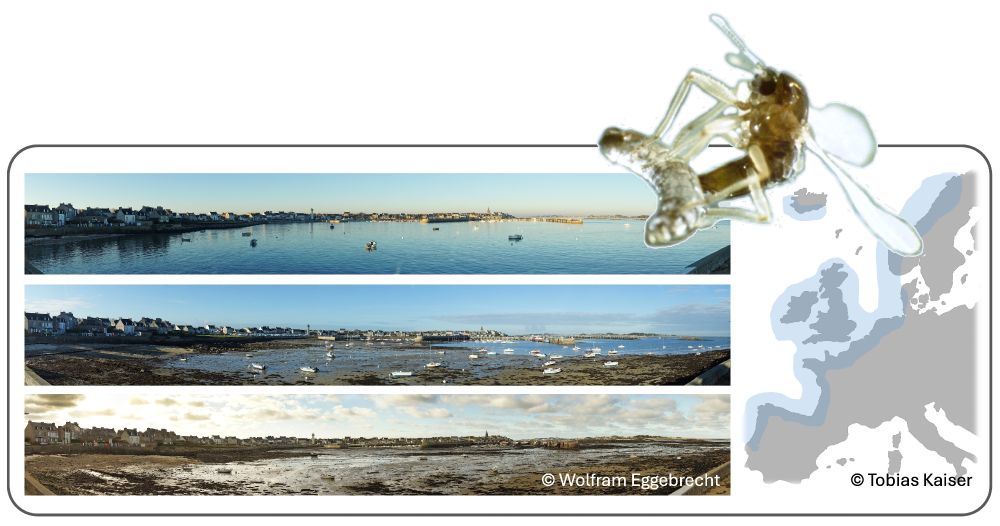
June 23, 2025 at 8:46 AM
#Moonstruck #Midges: Introducing Clunio marinus
#Clunio is a midge and a truly #marine #insect. You can find it on the #European #Atlantic #coast in the #intertidal zone. This is the region between the low #tide and high tide, alternating between marine and terrestrial conditions.
(1/5)
#Clunio is a midge and a truly #marine #insect. You can find it on the #European #Atlantic #coast in the #intertidal zone. This is the region between the low #tide and high tide, alternating between marine and terrestrial conditions.
(1/5)

